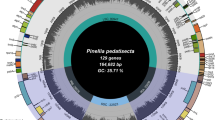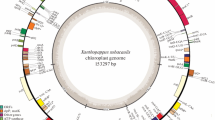Abstract
The genusPinus includes over 90 species with approximately 24 species native to Asia. We have analyzed the chloroplast (cp) DNA variation of 18Pinus species, including 15 Asian, two Eurasian, and one European species using seven restriction enzymes and ten non-overlapping probes and inferred their phylogenetic relationships. Results of phenetic and cladistic approaches to phylogeny reconstruction were largely in agreement, suggesting two major lineages within the genus and confirmed the ancient character of haploxylon and diploxylon subgenera. Species from sectionParrya appear to have diverged earliest from the hypothesized phylogenetic centre for the haploxylon pines, withP. bungeana andP. gerardiana forming two basal, monotypic lineages. The range of estimated pairwise nucleotide substitutions per site (\(\mathop d\limits^ \sim \)) was higher among haploxylon pines than among diploxylon species. CpDNA divergence was found to be low within the sectionSylvestres, relative to the divergence among haploxylon species, suggesting that the radiation of this group of taxa from its common ancestor occurred after the diversification of other groups. The low cpDNA divergence in this subsection corroborated earlier evidence for its phylogenetic cohesiveness and existence as a monophyletic group.
Similar content being viewed by others
References
Archie, J. W., 1989: Homoplasy excess ratios: new indices for measuring levels of homoplasy in phylogenetic systematics and a critique of the consistency index. — Syst. Zool.38: 253–269.
Bremer, B., 1991: Restriction data from chloroplast DNA for phylogenetic reconstruction: is there only one accurate way of scoring? — Pl. Syst. Evol.175: 39–54.
Burgh, J. van der, 1984: Phylogeny and biogeography of the genusPinus. — InFarjon, A., (Ed.): Pines—drawings and descriptions of the genusPinus, pp. 199–201. — Leiden: Brill, Backhuys.
Critchfield, W. B., Little, Jr, E. L., 1966: Geographic distribution of the pines of the world. — USDA/Forest Service Misc. Publ.991: 1–29.
DeBry, R. W., Slade, N. A., 1985: Cladistic analysis of restriction endonuclease cleavage maps within a maximum-likelihood framework. — Syst. Zool.34: 21–34.
Duffield, J. W., 1952: Relationships and species hybridization in the genusPinus. — Z. Forstgenetik1: 93–97.
El-Kassaby, Y. A., Sigurgeirsson, A., Szmidt, A. E., 1988: The use of restriction analysis of chloroplast DNA in classifying hybrid spruce seedlots. — InHällgren, J.-E., (Ed.): Frans Kempe Symposium: molecular genetics of forest trees, pp. 67–88. — Umeå: Swedish University of Agricultural Sciences.
Farjon, A., 1984: Pines: drawings and descriptions of the genusPinus. — Leiden: Brill, Backhuys.
Felsenstein, J., 1985: Confidence limits on phylogenies: an approach using the bootstrap. — Evolution39: 783–791.
Frankis, M. P., 1988: Generic interrelationships inPinaceae. — Notes Roy. Bot. Gard. Edinburgh45: 527–548.
Govindaraju, D., Lewis, P., Cullis, C., 1992: Phylogenetic analysis of pines using ribosomal DNA restriction fragment length polymorphisms. — Pl. Syst. Evol.179: 141–153.
Karalamangala, R. R., Nickrent, D. L., 1989: An electrophoretic study of representatives of subgenusDiploxylon ofPinus. — Canad. J. Bot.67: 1750–1759.
Klaus, W., 1989: Mediterranean pines and their history. — Pl. Syst. Evol.162: 133–163.
Kluge, A. G., Farris, J. S., 1969: Quantitative phyletics and the evolution of Anurans. — Syst. Zool.18: 1–32.
Kwei, Y. L., Lee, C. L., 1963: Anatomical studies of the leaf structure of Chinese pines. — Acta Bot. Sinica11: 44–58 (in Chinese).
Lidholm, J., Gustafsson, P., 1991: The chloroplast genome of the gymnospermPinus contorta: a physical map and a complete collection of overlapping clones. — Curr. Genet.20: 161–166.
Little, J. E. L., Critchfield, W. B., 1969: Subdivisions of the genusPinus (pines). — USDA Forest Service, Washington D.C., Miscell. Publication No. 1144.
Malusa, J., 1992: Phylogeny and biogeography of thePinyon pines (Pinus subsect.Cembroides). — Syst. Bot.17: 42–66.
McElroy, D., Moran, P., Bermingham, E., Kornfeld, I., 1992: REAP—An integrated environment for the manipulation and phylogenetic analysis of restriction data. — J. Heredity83: 157–158.
Millar, C. I., Strauss, S. H., Conkle, M. T., Westfall, R. D., 1988: Allozyme differentiation and biosystematics of the Californian closed-cone pines (Pinus subsect.Oocarpae). — Syst. Bot.13: 351–370.
Miller, J. C., 1991: Restsite: a phylogenetic program that sorts raw restriction data. — J. Heredity82: 262–263.
Miller, Jr, C. N., 1976: Early evolution in thePinaceae. — Rev. Paleobot. Palynol.21: 101–117.
Mirov, N. T., 1967: The genusPinus. — New York: Ronald Press.
Nei, M., 1987: Molecular evolutionary genetics. — New York: Columbia University Press.
—, 1990: A simple method for estimating average number of nucleotide substitutions within and between populations from restriction data. — Genetics125: 873–879.
Penny, D., Hendy, M. D., Steel, M. A., 1992: Progress with methods for constructing evolutionary trees. — TREE7: 73–79.
Price, R. A., Olsen-Stojkovich, J., Lowenstein, J. M., 1987: Relationships among the genera ofPinaceae: an immunological comparison. — Syst. Bot.12: 91–97.
Rieseberg, L. H., Brunsfeld, S. J., 1992: Molecular evidence and plant introgression. — InSoltis, P. L., Soltis, D. E., Doyle, J. J., (Eds): Molecular systematics of plants, pp. 151–176. — New York, London: Chapman and Hall.
Saitou, N., Nei, M., 1987: The neighbor-joining method: a new method for reconstructing phylogenetic trees. — Mol. Biol. Evol.4: 406–425.
Sandbrink, J. M., Van Brederode, J., 1991: Different approaches to analysis of restriction fragment patterns of chloroplast DNA and phylogenetic relationships inSilene sectionSiphonomorpha (Caryophyllaceae). — Biochem. Syst. Ecol.19: 559–567.
Saylor, L. C., 1972: Karyotype analysis of the genusPinus—subgenusPinus. — Silvae Genet.21: 155–163.
—, 1983: Karyotype analysis of the genusPinus—subgenusStrobus. — Silvae Genet.32: 119–124.
Schaffer, H. E., Sederoff, R., 1981: Improved estimation of DNA fragment lengths from agarose gels. — Analyt. Biochem.115: 113–122.
Shaw, G. R., 1914: The genusPinus. — Publ. Arnold Arbor.5: 1–96.
Shurkhal, A., Podogas, A., Zhivotovki, L., 1992: Allozyme differentiation in the genusPinus. — Silvae Genet.21: 105–109.
Sigurgeirsson, A., 1992: Insights into the evolution ofPicea inferred from chloroplast DNA. — PhD Thesis, Swedish University of Agricultural Sciences, Faculty of Forestry, Department of Forest Genetics and Plant Physiology, Umeå, ISBN 91-576-4617-1.
Strauss, S. H., Doerksen, A. H., 1990: Restriction fragment analysis of pine phylogeny. — Evolution44: 1081–1096.
Sytsma, K. J., Gottlieb, L. D., 1986: Chloroplast DNA evolution and phylogenetic relationships inClarkia sect.Peripetasma (Onagraceae). — Evolution40: 1248–1261.
Szmidt, A. E., 1991: Phylogenetic and applied studies on chloroplast genome in forest conifers. — InFineschi, S., Malvolti, M. E., Cannata, F., Hattemer, H. H., (Eds): Biochemical markers in the population genetics of forest trees, pp. 185–196. — The Hague: Academic Publishing.
—, 1992a: DNA markers in forest genetics. — InMüller-Starck, G., Ziehe, M., (Eds): Genetic variation in forest tree populations in Europe, pp. 79–94. — Frankfurt am Main: Sauerländer.
—, 1993: Molecular systematics and patterns of geographic differentiation in geographic varieties ofPinus sylvestris (L.) andP. densiflora (Sieb. etZucc). — Theor. Appl. Genet.86: 159–165.
—, 1988: Classifying seedlots ofPicea sitchensis andP. glauca in zones of introgression using restriction analysis of chloroplast DNA. — Theor. Appl. Genet.76: 841–845.
—, 1986: DNA extraction and preliminary characterization of chloroplast DNA fromPinus sylvestris andPinus contorta. — InLindgren, D., (Ed.): Frans Kempe Symposium: provenances and forest tree breeding for high latitudes, pp. 269–280. — Umeå: Swedish University of Agricultural Sciences.
—, 1988: Genetic relationships amongPinus species based on chloroplast DNA polymorphism. — InHällgren, J.-E., (Ed.): Frans Kempe Symposium: molecular genetics of forest trees, pp. 33–47. — Umeå: Swedish University of Agricultural Sciences.
Wagner, D. B., Furnier, G. R., Saghai-Maroof, M. A., Williams, S. M., Dancik, B. P., Allard, R. W., 1987: Chloroplast DNA polymorphisms in lodgepole and jack pines and their hybrids. — Proc. Natl. Acad. Sci. USA84: 2097–2100.
Wang, X.-R., 1992: Genetic diversity and evolution of EurasianPinus species. — PhD thesis, Swedish University of Agricultural Sciences, Department of Forest Genetics and Plant Physiology, Umeå, ISBN 91-576-4641-4.
—, 1990: Evolutionary analysis ofPinus densata (Masters), a putative Tertiary hybrid. 2. A study using species-specific chloroplast DNA markers. — Theor. Appl. Genet.80: 641–647.
—, 1991a: Allozyme differentiation among populations ofPinus sylvestris L. from Sweden and China. — Hereditas114: 219–226.
—, 1991b: A chloroplast DNA story about Asiatic pines. — InFineschi, S., Malvolti, M. E., Cannata, F., Hattemer, H. H., (Eds): Biochemical markers in the population genetics of forest trees, pp. 209–216. — The Hague: Academic Publishing.
Wheeler, N. C., Guries, R. P., O'Malley, D. M., 1983: Biosystematics of the genusPinus, subsectionContortae. — Biochem. Syst. Ecol.11: 333–340.
Author information
Authors and Affiliations
Rights and permissions
About this article
Cite this article
Wang, XR., Szmidt, A.E. Chloroplast DNA-based phylogeny of AsianPinus species (Pinaceae). Pl Syst Evol 188, 197–211 (1993). https://doi.org/10.1007/BF00937728
Received:
Revised:
Accepted:
Issue Date:
DOI: https://doi.org/10.1007/BF00937728




